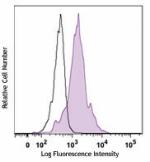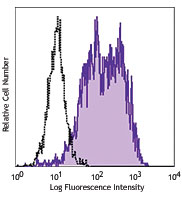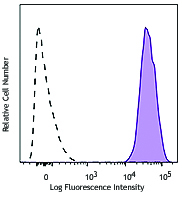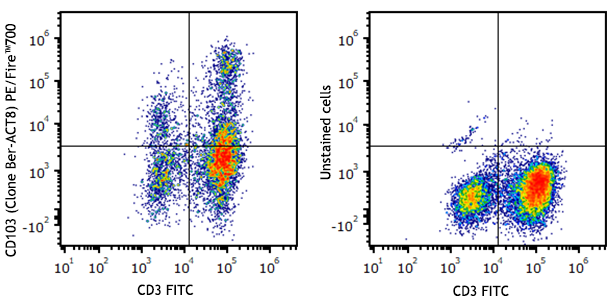- Clone
- 22-19-12 (See other available formats)
- Regulatory Status
- RUO
- Other Names
- SRPSOX, CXCXLG16, SR-PSOX
- Isotype
- Mouse IgG1, κ
- Ave. Rating
- Submit a Review
- Product Citations
- 2 publications

| Cat # | Size | Price | Quantity Check Availability | Save | ||
|---|---|---|---|---|---|---|
| 360803 | 25 tests | 123€ | ||||
| 360804 | 100 tests | 238€ | ||||
CXCL16, a 27 kD chemokine, exists in membrane-bound and soluble forms. Unlike classic chemokines, CXCL16 possesses a mucin-like stalk, a transmembrane domain, and a cytoplasmic tail with a tyrosine phosphorylation domain, allowing it to be expressed on the cell surface. Structurally, it is similar to fractalkine. It is expressed by dendritic cells, monocytes, and T cells. T cells can also migrate in response to CXCL16.
CXCL16 can also act as a scavenger receptor on macrophages. Its receptor is CXCR6/Bonzo. It can bind oxidized LDL and thus may play an important role in atherosclerosis. Recent studies have shown a role for CXCL16 in kidney fibrosis and in autoimmunity. CXCL16 is also a co-receptor for HIV.
Product Details
- Verified Reactivity
- Human
- Antibody Type
- Monoclonal
- Host Species
- Mouse
- Immunogen
- Purified human SR-PSOX-Fc fusion protein
- Formulation
- Phosphate-buffered solution, pH 7.2, containing 0.09% sodium azide and BSA (origin USA)
- Preparation
- The antibody was purified by affinity chromatography and conjugated with PE under optimal conditions.
- Concentration
- Lot-specific (to obtain lot-specific concentration and expiration, please enter the lot number in our Certificate of Analysis online tool.)
- Storage & Handling
- The antibody solution should be stored undiluted between 2°C and 8°C, and protected from prolonged exposure to light. Do not freeze.
- Application
-
FC - Quality tested
- Recommended Usage
-
Each lot of this antibody is quality control tested by immunofluorescent staining with flow cytometric analysis. For flow cytometric staining, the suggested use of this reagent is 5 µl per million cells in 100 µl staining volume or 5 µl per 100 µl of whole blood.
- Excitation Laser
-
Blue Laser (488 nm)
Green Laser (532 nm)/Yellow-Green Laser (561 nm)
- Application Notes
-
Additional reported applications (for the relevant formats of this clone) include: in vitro blocking of chemotactic activity of CXCR6 expressing cells1. Clone 22-19-12 recognizes the chemokine domain of CXCL16 and has been shown to inhibit chemotactic activity to CXCR6-expressing cells by soluble CXCL16.1
-
Application References
(PubMed link indicates BioLegend citation) -
- Shimaoka T, et al. 2003. J. Immunol. 171:1647. (FC, Block)
- Product Citations
-
- RRID
-
AB_2563010 (BioLegend Cat. No. 360803)
AB_2563011 (BioLegend Cat. No. 360804)
Antigen Details
- Structure
- ~27 kD, exists as a membrane bound and soluble forms
- Distribution
- Produced by dendritic cells and T cells
- Function
- Binds to oxidized LDL and may play an important role in atherosclerosis
- Interaction
- Interacts with CXCR6/Bonzo
- Ligand/Receptor
- CXCR6
- Cell Type
- Dendritic cells, T cells
- Biology Area
- Immunology, Innate Immunity
- Molecular Family
- Cytokines/Chemokines
- Antigen References
-
1. Matloubian M, et al. 2000. Nat. Immunol. 1:298.
2. Wilbanks A, et al. 2001. J. Immunol. 166:5145.
3. Shimaoka T, et al. 2003. J. Immuniol. 171:1647.
4. Chandrasekar B, et al. 2004. J. Biol. Chem. 179:3188.
5. Shimaoka T, et al. 2004. J. Leukoc. Biol. 75:267. - Gene ID
- 58191 View all products for this Gene ID
- UniProt
- View information about CXCL16 on UniProt.org
Related FAQs
- What type of PE do you use in your conjugates?
- We use R-PE in our conjugates.
Other Formats
View All CXCL16 Reagents Request Custom Conjugation| Description | Clone | Applications |
|---|---|---|
| Purified anti-human CXCL16 | 22-19-12 | FC |
| PE anti-human CXCL16 | 22-19-12 | FC |
Customers Also Purchased
Compare Data Across All Formats
This data display is provided for general comparisons between formats.
Your actual data may vary due to variations in samples, target cells, instruments and their settings, staining conditions, and other factors.
If you need assistance with selecting the best format contact our expert technical support team.
-
Purified anti-human CXCL16

Peripheral blood monocytes were stained with purified anti-h... -
PE anti-human CXCL16

Peripheral blood monocytes were stained with anti-human CXCL...

 Login / Register
Login / Register 



















Follow Us